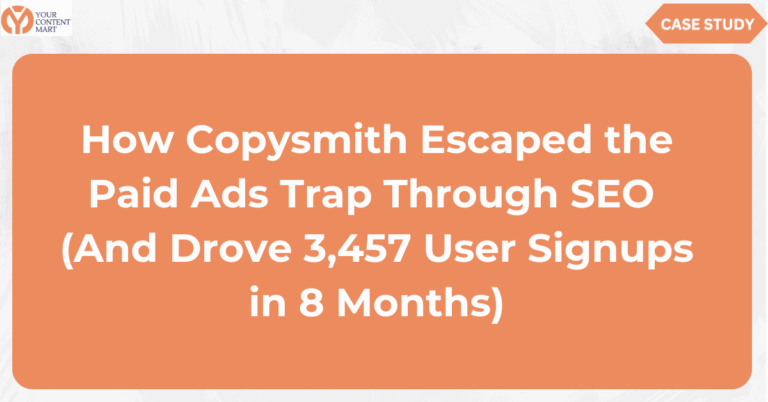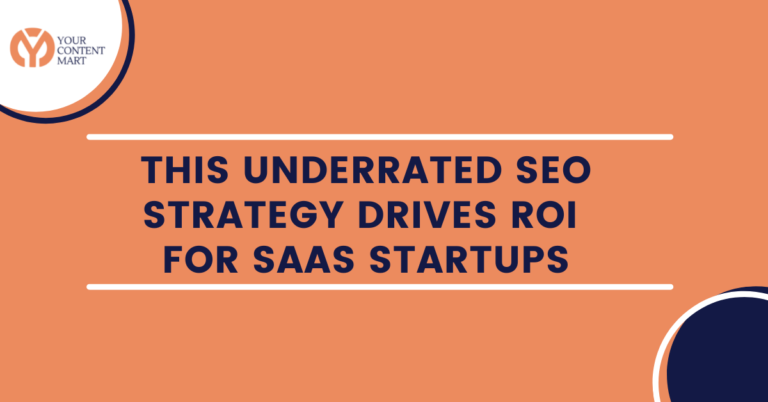Let me ask you a question…
The last time you signed up for a SaaS product, what was the buyer journey like?
Did you:
- Discover a blog post via Google search
- Download an eBook/content upgrade after reading the article, and
- Become a user after receiving a series of emails educating you about the product?
This is the traditional content marketing strategy that a lot of SaaS companies still use in 2021.
But here is a fact…
That content marketing model is “broken”.
And if you’re a SaaS company that really wants to get results (and not crickets) from your content marketing efforts, then you should change your strategy now.
Here is why…
Most buyers don’t want to go through the typical traditional marketing route. They don’t want to receive an email sequence telling them why they should sign up for a 7-day or 14-day or 30-day free trial of your product.
Rather, they want answers to their questions, and solutions to their pain point now.
Not only that…
They want you to show them exactly how your product can solve the problems they’re facing right now.
If you’ve gotten their attention through that amazing piece of content, congratulations.
All you need to do next is show them the next logical step (which is to try out your product and see if it works out for them).
Anything else might generate “leads”, who NEVER open your emails, and most likely mark you as spam in the long run.
So, what can you do right now to change this narrative for your SaaS business?
Simple…
Start with the buyer in mind and use your product as an inspiration for any piece of content you want to drive user signups from.
That’s exactly what product-led content marketing is all about.
After reading this post, you’ll learn:
- What product-led content actually means
- Why product-led content should be a core part of your SaaS content marketing strategy.
- Product-led content examples from SaaS companies.
- How to create product-led content for your SaaS company.
Prefer video content?
Check out the video below:
Let’s get started.
TABLE OF CONTENTS
What is Product-Led Content
Product-led content is when you create content pieces that address the pain points of your audience and show them exactly how to solve them using your software.
If you want your content marketing strategy to be product-led, target keywords where you can weave in your product as a solution to a specific problem that your audience has.
With this strategy, you must think of the business potential of each keyword you target.
If it’s possible to weave your product into the content you create, it might be worth it going after the keyword.
Else, it might not be a good idea to target that keyword.
Benefits Of Implementing a Product-Led Content Marketing Strategy
Here are some reasons you should use product-led content marketing as a strategy for your SaaS business.
It shows people how to use your product
One of the biggest challenges that SaaS founders face is educating their audience about their products. Especially if it has many features and serves different industries.
With product-led content, you can show a reader how to use some specific features in your software, even before signing up for a free trial.
And the best part…
You do this in a non-salesy way.
This will make the reader more confident about using your product when they become a paying customer.
It creates more qualified leads
You’re most likely investing time and resources in SaaS content writing, to get more people to try out your product, and eventually pay for it. For this to happen, you need more qualified leads.
If you follow the traditional marketing route, chances are that you’ll get leads into your funnel, who download your eBook and don’t have any interest in your product.
With product-led content marketing, you stand a better chance of generating qualified leads, who will actually sign up for a free trial of your product after reading an article you published.
It supports user retention
One of the reasons users churn (especially for SaaS), is when they find it difficult to use your product.
By creating product-led content, you find it much easier to retain your users. This is because they’ll most likely be knowledgeable about how your product works even before signing up.
That’s not all…
You can still use product-led content to highlight new features that you want your existing customers to know about.
It establishes your product as the solution to the problem(s) your readers have
Product-led content is solution-focused.
So, you’re not creating a piece of content to rank high on the first page of Google alone. Rather, you want to provide solutions to the problems your readers currently face, using your product.
When you do, they will remember that product that helped them solve the problem(s) they had then.
And even if they don’t sign up now, they’ll most likely do so, in the long run.
It makes your product memorable for readers
If you read a listicle about random “blog post ideas” some days ago, chances are that you have forgotten about the author or the company they represent.
However, if you read an article on the same topic, where the author shows you how to use their software to create new blog post ideas, you’d most likely remember the product, isn’t it?
That’s exactly what you stand to gain if you use product-led content as a SaaS company.
When you do, you imprint your product and how it works in the minds of your readers. Even if they don’t convert into users right away, they’ll always remember your product.
How To Create Product-Led Content From Scratch
Ready to create a product-led content piece for your SaaS company?
Let me walk you through a 5-step process that you can use right away to make that happen.
Step 1: Establish the problem or pain point of your target audience
As I mentioned before, product-led content focuses on the problems your target audience is facing, and how your product can solve them.
This is why the first step in creating a piece of content that is product-led, is to figure out exactly what these problems and pain points are.
The reason is simple…
If you don’t know what keeps your audience awake at night, it’d be difficult to create a content piece that’d resonate with them.
So, if you already have some existing customers, the best way to go about this is to reach out to some of them and ask questions that reveal these pain points and problems.
Take for instance, if your SaaS is an outreach tool that helps B2B companies get new customers and clients, you can ask them probing questions like:
- How are you generating leads for your business right now?
- What’s your biggest challenge with cold email outreach?
- What other channels work best for your company to generate leads aside from cold email outreach?
- What do you wish someone told you about our tool before you signed up?
- Mention 3-5 outreach tools that you’ve tried out before?
With questions like these, you’d easily identify the problems and pain points they’re currently facing. Which will eventually help you to create content that solves them.
This is why at Your Content Mart, the first phase in the Pentascope Content Marketing System is “Audience Research”. That way, we’re able to know exactly who we’re creating content for, and the type of content that’ll resonate with them.
Step 2: Agitate the problem (and explain why it’s holding them back)
Once you’ve figured out the pain points your audience has, now is the time to create a product-led content piece.
In the first part of the piece, you should agitate the problems you’ve identified, and show them how it’s holding them back from achieving their business goals.
Take this piece you’re reading as an example.
The problem I identified is the fact that SaaS companies fail to educate their audience about their products and show them how it works within their content pieces.
To agitate this problem, I explained that today’s users would most likely not open your emails, and you might not get any user signups if you still follow the traditional SaaS marketing route.
In the same vein, you can do this for your SaaS.
Still on the previous example of an outreach tool for B2B companies.
If you figured out that most of your customers are generating their B2B leads from SEO.
You can agitate the problem by explaining how SEO typically takes around 6-12 months before seeing results, and how that could affect their company’s growth.
Step 3: Outline potential solutions they can try out
Once you’ve exaggerated the pain point, they’d most likely be interested in reading what the solutions are.
Here is where you should show them that you care.
If you want to get the best results from this strategy, you should resist the urge to be salesy.
Rather, you should show them the different solutions that are available (excluding your product), which they can try out.
Doing this will make them trust you more, and not think that you’re all about selling your product to them.
For example…
If the biggest challenge of your B2B SaaS outreach tool clients is “finding the email address of the right person to contact”
Then you should proceed to show them the different tools and strategies they can use to find people’s email addresses online.
Step 4: Show readers the power of your product
Now that you have your audience’s attention and gained their trust, it’s time to weave your product into the narrative.
A mistake that a lot of SaaS companies make is to think that showing readers how their software works in a relevant piece of content is salesy.
Trust me it isn’t.
In fact, if you do it right, chances are that you’ll make readers fall in love with your content and always want to come back for more.
When showing readers how your software works, make use of screenshots, videos, illustrations, and GIFs.
That way, they’ll have a better understanding of how your product works.
Step 5: Guide users on the next step to take
Don’t assume that your readers know what to do next after reading your content. This is why you should guide and tell them the specific step you want them to take next.
For a SaaS product, the next logical step could be for a reader to sign up for a free trial or register for a demo of your product.
Irrespective of what the step is, tell the reader exactly what you want them to do next.
Once you do, chances are that they’ll take action, if they’re interested in your product.
However, if you don’t, they’d most likely not convert after reading your article.
If you want the reader to try out your SaaS, you could say something like: “Click here to sign up for a 14-day free trial of XYZ”.
If you want them to register for a demo, you could say something along the lines of:
“Schedule a 30-minute demo with one of our company’s representatives through this link”.
Product-Led Content Examples You Can Learn From
Need inspiration on how to execute a product-led content strategy for your SaaS company? Here are two (2) examples of SaaS companies that you can learn from.
How Ahrefs is Dominating The Competitive SEO Industry With Product-led Content
Ask any content marketer or SEO expert around you, and they’ll tell you how they enjoy reading the Ahrefs blog.
Aside from being one of the most valuable and actionable blogs out there. They also excel at promoting their product in each blog post.
Take this post about Quora Marketing for example.
The target audience is marketers who want to level up their engagement on Quora and get better results from using the platform.
And one of the challenges they will most likely have is identifying good questions to answer.
And guess what?
In the blog post, Ahrefs promoted one of their core features as a great way to find these questions.

If you’re a marketer who has never used Ahrefs before and has this challenge, you’ll most likely be curious about the Site Explorer and would be willing to try it out.
If you’re an existing customer who faces this challenge too, you’ll want to check the feature out.
Here’s another example…
If you build links for yourself or clients, you know how complex broken link building can be.
One of the biggest challenges that SEOs have with this tactic is identifying broken link building opportunities.
So in this guide about broken link building, Ahrefs mentioned this and also suggests its tool as the best solution.
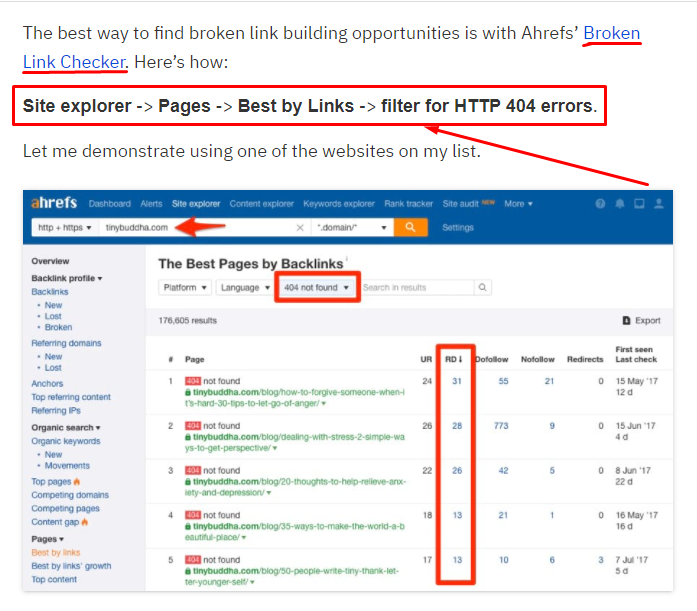
They even go a step further to share how you can find expired domains with links.

As you can see, Ahrefs uses product-led content to show its audience how effective their product is for identifying broken links.
By doing this, any potential user knows exactly how this works even before trying the product out. Likewise, it’s a great way to keep their existing customers and show them how powerful the product they’re using is.
In a recent Twitter thread, the CMO of Ahrefs Tim Soulo highlighted the ROI of investing in product-led content for the company.
Let's talk about the "ROI of Content Marketing."
— Tim Soulo 🇺🇦 (@timsoulo) March 23, 2021
Far too often us marketers get challenged with this question by our boss (or our client):
– How do I know that my investment in content will guarantee a positive return? …& how can I *MEASURE* it?
[Read more..]
According to him, here are some results product-led content has generated so far for them.
- Brings in new customers
- Improves the retention of existing customers
- Re-activate past customers
- Helps with revenue expansion
- Fuels the word of mouth
- Leads to the “Mere Exposure Effect”
- Helps build a solid reputation in the industry
- Fuels paid acquisition strategies
- Reduces support requests
How Hotjar Uses Product-led Content To Show Readers The Power Of Its Tool
Another great example of product-led content is the website analytics tool, Hotjar.
They’ve found a way to find high-intent keywords and show their audience how their product fits in.
This post on Hotjar’s blog about Open-Ended questions is a great example of product-led content.
Anyone searching for this keyword will like to know examples of open-ended questions and how to use them on their website or pages to move conversations forward.
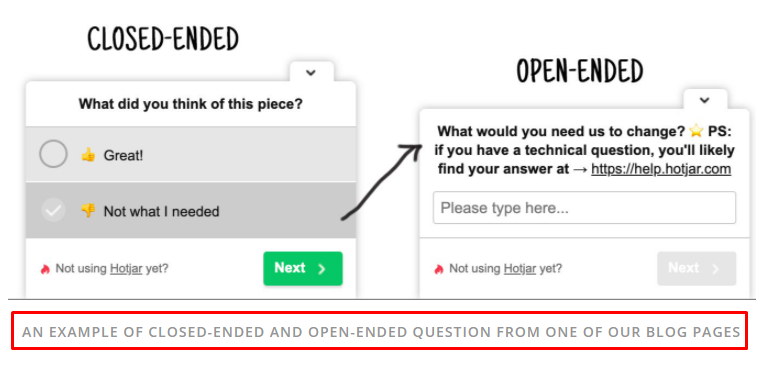
As you can see, the Hotjar team combines these two instances into this example. First, it’s from one of their blog pages. Second, it’s pulled directly from the tool.
Anyone who reads this post would have a good idea of the difference between open-ended and closed-ended questions. Also, they’ll have a better picture of how to use Hotjar to set this up on their website.
They also show readers how to use some specific features on the tool within the blog posts.
Here’s an example below.

If you stumbled on this blog post and want to run surveys on your website, you’ll have an idea of a Hotjar feature that’ll be a perfect fit for you.
And if you’re an existing customer, reading this post will make you understand how powerful the feedback tool is.
Hotjar also uses product-led content to show its readers how existing customers use the tool for various use cases.
In this post about user personas, they shared exactly how Smallpdf used the Hotjar survey tool to run polls on their website.
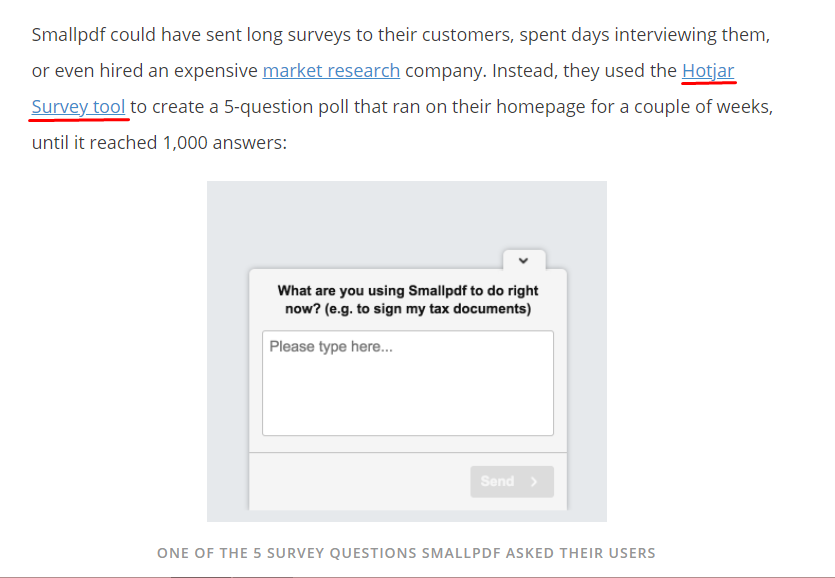
Using examples like this from existing customers shows their audience the different things they can do with the tool. Most readers will put themselves in the same shoes as those who already use the tool, and if they ever need to run surveys on their website, they’ll try it out.
And the best part…
Using product-led content has been instrumental in driving Hotjar’s growth.
For example, the post about open-ended questions currently brings in over 36,000 organic traffic visitors every month according to SEMrush.

It also ranks number 1 on Google for high-volume queries such as:
- Open-ended questions
- Open-ended questions examples
- Closed-ended questions
- And so on.
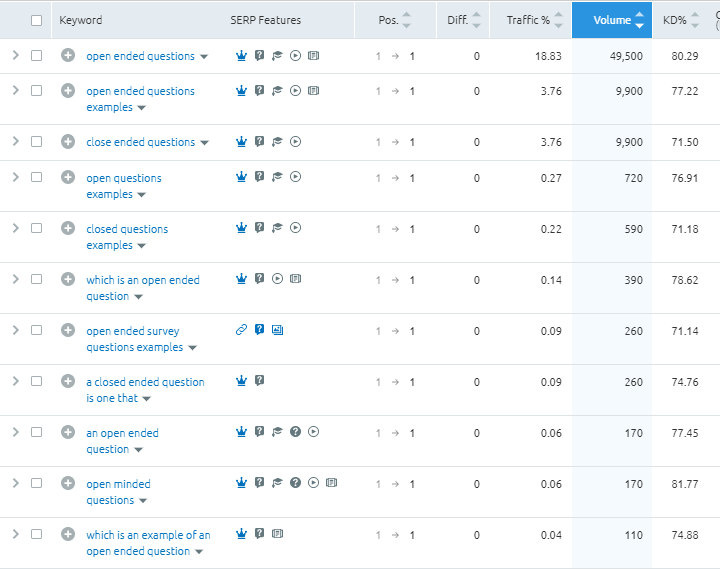
Result-wise, it’s been great for them as well.
According to Dr. Fio Dossetto, the former senior editor at Hotjar, the piece about user personas was one of the top ten drivers of user signups and MQLs, throughout her stay at the company.
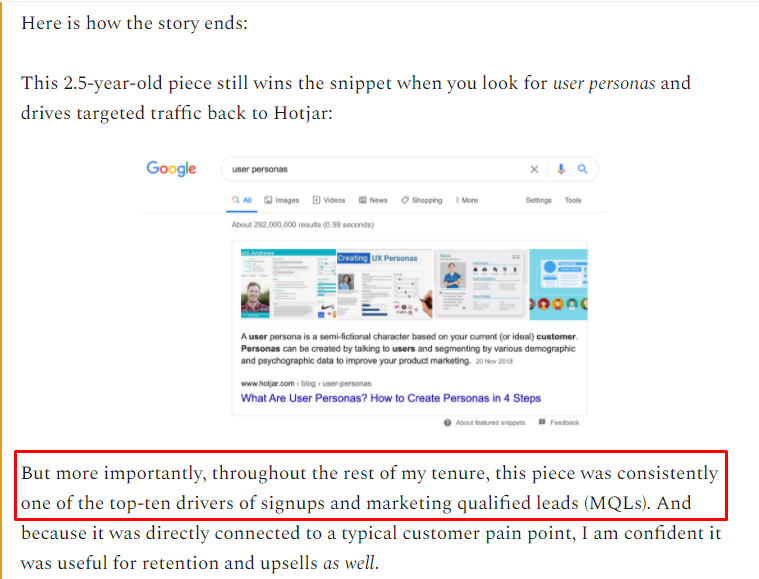
How Exactly Do You Write Product-led Content for a SaaS brand?
I reached out to Dr. Fio Dossetto (Founder, Content Folks), and she recommends these 3 methods for writing product-led content.
These include:
Keyword-based method: This entails finding relevant keywords for your SaaS product, applying the 0-3 impact score to determine if your product can be mentioned in the content, and adding your unique angle to it.
Customer-based method: This involves interviewing your SaaS customers to know the exact features they’re using in your product. Afterward, you can find an angle and a keyword to optimize it for.
Existing content method: In this case, you need to look at your successful pieces based on some predetermined metrics, apply the business score to see how you can add your product to the content. Finally, you edit the content before hitting publish.
Final Thoughts: Acquire More User Signups Through Product-led Content
Investing in content marketing should help you generate more user signups for your SaaS business.
That way, more people can try out your product to see how it works. And you can convert them to paying customers in the long run.
You can make this happen directly from the content you publish on your website using product-led content. Without forcing users to give you their email addresses in exchange for a gated piece of content.
As a SaaS content marketing agency, this is one of the content strategies that we implement for our clients.
If you’d like us to help with your SaaS content marketing strategy, click on this link to get a free content analysis from our lead content strategist.
You can as well join our newsletter, SaaS Growth Bites, to receive exclusive insights and tips every Thursday, on the best way to grow a SaaS business using content marketing.



